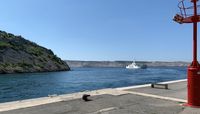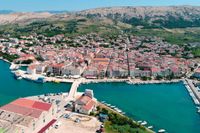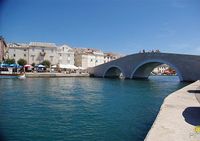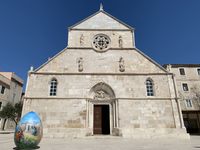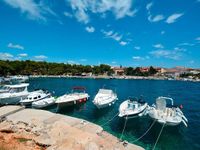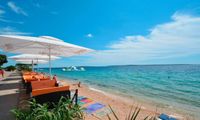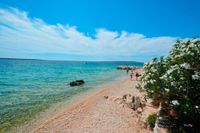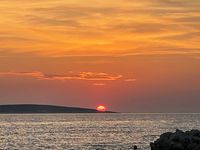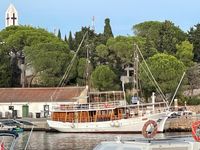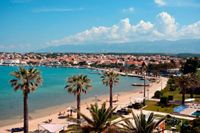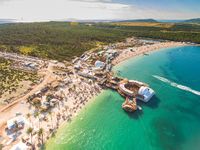The Island of Pag - the island with 2 faces
Standing in Prizna harbour waiting for the car ferry to Žigljen, you can see the bare bora side of the Island of Pag in the distance and wonder whether you made the right decision to spend the best time of the year here.
After a 15-minute ferry journey, the island welcomes you with a sight that resembles a barren, moon-like landscape, partly man-made and partly created by extreme downdraughts that hit the island from the Velebit Mountains.
But as you drive westwards over the small mountain ridge, it becomes greener and more attractive. Thyme and sage bushes grow behind the ancient natural stone walls and the further you get to the west coast, the more the island is lined with pine forests, holm oak woods and olive trees.
In addition to fishing and sea salt production, viticulture and tourism play an important economic role.
Paški sir (Pag cheese) is an internationally renowned cheese speciality and olive oil is produced for sale in a small factory from the fruit of the thousand-year-old olive trees.
The Island of Pag, in the north of the Dalmatia region, is one of the most popular holiday destinations in Croatia. The island, located north of Zadar and accessible either via the bridge of Pag or by ferry, is the fifth largest island in the country at 284 square kilometres.
Along the more than 300 kilometres of coastline on the Island of Pag, beautiful beaches and enchanting bays invite you to spend unforgettable days at the beach. Family beaches such as the sandy beach Planjka or the town beach Prosika in the town of Pag are perfect for young and old swimmers. For young guests and the young at heart, the famous party beach in Zrće, which embodies the heart of Croatian nightlife, is the "place to be". For active holidaymakers, there is a wide range of different sports and leisure activities on and around the large beaches.
Pag - the island's capital
The town of Pag, where we can admire it today, was planned and founded in the 15th century according to the plans of the famous contemporary architect Juraj Dalmatinac. Pag is characterised by a central square and four main streets that run along its entire length and divide the town into four separate districts.
Of the beautiful buildings that are worth a visit, the Church of the Assumption of the Virgin Mary, the Ducal Palace and the last of the nine towers still standing on the island are not to be missed.
The best starting point for exploring the town is the pedestrian bridge in the old town centre, which leads to Velika Ulica. Numerous restaurants, shops, cafés and bars offering local delicacies and souvenirs are clustered around Pag's main square and the promenade. Popular souvenirs include Pag lace, Pag cheese and the excellent Zutica wine from Pag. In addition to the lively promenade, there are also small streets where historic buildings can be admired. The town of Pag is the ideal mix of hustle and bustle and serenity.
Pag offers various possibilities as a starting point for excursions to the largest Croatian national parks, which are located nearby. The Kornati National Park, an archipelago of small islands whose beauty will take your breath away, or the Plitvice Lakes, famous from the Winnetou film series.
The largest sandy beach in the immediate vicinity of the old town centre is called Prosika. The lagoons of Pag are home to 27 kilometres of sandy, pebble and stone beaches, the most famous of which are Zrće, Janjeće vode, Beritnica, Sveti duh, Sveti Marko, Dubrava, Bošana, Caska, Ručica, Slana, Malin, Veliki Zaton, Bijele Stijene, Veli Bok, Mali Bok and Kotica.
Mandre - a calming family oasis
The small fishing village of Mandre is located about 4 kilometres from ACI Marina Šimuni (the northern entrance to Dalmatia, the last marina in the Kvarner archipelago) and about 10 kilometres from the famous Zrće beach. Mandre, with its idyllic harbour, is surrounded by dense oak and pine groves and offers a beautiful view of the islands of Silbu and Olib and the surrounding islands of Maun and Škrda. Here, where the sun shines almost all year round, the clear sea and beautiful pebble beaches attract visitors looking for a peaceful holiday with the family.
The very hospitable village shows its most beautiful side at the sheltered little harbour. This is where the old village centre of Mandre is located and where most of the daily life takes place. The pine-lined harbour basin is very idyllic, with fishing nets stretched out to dry and boats gently bobbing on the waves, and the islands, which are clearly visible from here, provide a typically Mediterranean backdrop that is perfect for postcards.
Various restaurants cater for the physical well-being of summer guests with fresh fish and regional specialities, some of which can be enjoyed on terraces with direct sea views. In a bay in the centre of Mandre lies the small Mala Mandra beach - awarded the blue flag in 2006 - a unique pebble beach that is ideal for children due to its access to the sea. Here, the municipality has anchored a floating water park in the seabed within sight of the beach as a new attraction for young and old water rats.
Novalja - the world-famous party stronghold
Novalja is located in the north-western part of the island of Pag and is the tourist centre of the island, but today it is primarily known as a destination for young people looking for summer fun. Zrće beach, which is considered the epicentre of this new trend, is also known as the "Croatian Ibiza" - the fun never stops here. The population can sometimes swell from 3,500 to 40,000 in the summer months. The long promenade that stretches through the whole of Novalja is then crowded with tourists who want to stroll along in the evening or satisfy their hunger in one of the countless restaurants serving Croatian and international cuisine.
The nightlife offers various options - from numerous cafés, bars and restaurants for every taste and budget. However, the biggest night party takes place on the nearby Zrće Beach, which is easily accessible either by car or by public transport. Zrće Beach is the most famous beach in Novalja, but also in Croatia. It is now synonymous with summer parties and is one of the largest party zones in Europe. A wide variety of sports activities are carried out here, such as: B. Bungee jumping, jet skiing, parasailing, cage ball and wakeboarding are offered. Other special features of this beach include the Papaya, Kalypso, Aquarius and Noa clubs - where the parties never end. Every year, the world's most famous DJs ensure a party and an endless atmosphere here.
